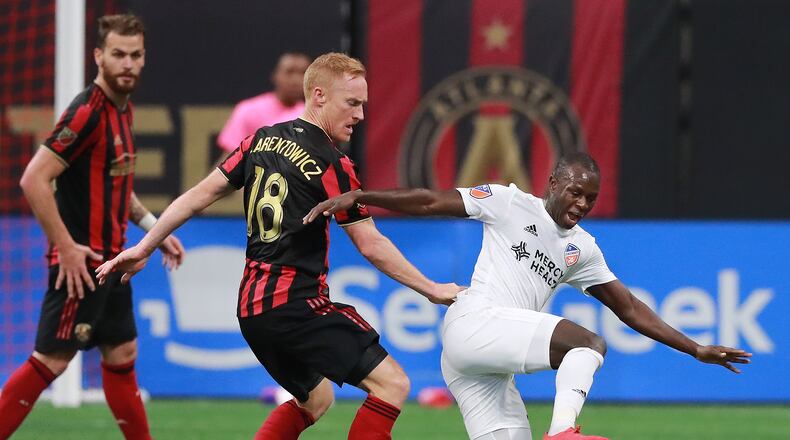If Atlanta United’s midfield has looked wonky in the season’s first seven games, well, it was.
Seven games in 21 days limited training time. That lack of training, switching formations and an abundance of fatigue – an odd combination – meant execution and decision-making that were sharp the previous two seasons were dulled.
With tired minds and rubber legs, the goals dried up because the midfielders said they had difficulty getting to the ball to the attacking players in the right place at the right time.
The result: a 2-3-2 record. One goal or less scored in six of those games. A winless start three games into the MLS season. An early exit from the Champions League.
“We’ve been a little off,” Jeff Larentowicz said. “I think that comes from not having the ability to train as much as we have in the past before games and we’ve gone through a few shifts tactically and that creates a bit of … a change involved. Without training, you aren’t as accustomed or as comfortable doing things you normally do, especially with the change.”
The midfield manifest is as follows:
Manager Frank de Boer elected to start the season with a four-man midfield in a 3-4-3 formation. The team scored one goal, off a deflection, against Herediano, four in the return leg of the series, none against D.C. United, none at Monterrey and one against Cincinnati in the first game at Mercedes-Benz Stadium this season. Not only were the lack of goals worrisome, but the team wasn’t putting a lot of shots on goal, either.
“I think with so many games in a row we didn’t have much time to work during the week,” said midfielder Eric Remedi, who added he could feel the weight of the games in last week’s 1-1 draw with Philadelphia. “It was more about watching film of the opponents, see what they do and try to get ready for the game.”
That midfield decision continued until the second half of the second leg against Monterrey. Trailing 3-0 and with not much time remaining to try to stay alive in the Champions League, de Boer switched to a three-man midfield, or five depending upon how deep the wide forwards dropped, in a 4-3-3 formation, similar to what the team used the majority of the previous two seasons. Atlanta United soon scored when Darlington Nagbe found Josef Martinez with a crisp pass and shot.
The team switched back to the 3-4-3, but this time to a four-man midfield in a diamond shape, a few days later against Philadelphia. The decision was made to match up tactically with the Union. But the Five Stripes struggled to create scoring opportunities, not putting a shot on goal until the second half.
“I think we’ve had a lot of possession,” Remedi said. “What we are missing are those clear chances. I think we’ve had a little bad luck. Hopefully, as the games go on and we get more comfortable we will create more chances and get back to scoring those goals.”
The spacing in a 3-4-3 is different than in a 4-3-3 or 3-5-2, according to Larentowicz. Instead of being weighted toward the back, it is weighted toward the middle. As a result, unfamiliar spaces can open. That is what happened in the game against Philadelphia when Alejandro Bedoya found himself in space down the right flank. He put in a good cross that eventually resulted in Brad Guzan’s black eye.
Recognizing that the diamond wasn’t working, the team switch to a 4-3-3 in the first half, and then in the second to a 3-5-2, which was the formation it used in last year’s playoffs to win the MLS Cup, and soon scored the goal to earn a 1-1 draw with the Union.
Larentowicz said that familiarity of playing in a familiar formation may have helped. Atlanta United will next play March 30 at Columbus, giving de Boer needed time to work on whatever formation he feels will work best with the personnel. Larentowicz said if the 3-4-3 is the choice, he is confident that the more team trains it the better they will execute.
“If it’s something you’ve done in the past, you saw it at the end of the Monterrey game, you kind of switch to something you are familiar with it fits like a lock in key,” he said. “If you are trying something new like we were at the beginning of the game, it depends upon the prep you’ve been able to do and if you are ready for that. I think that once we made a shift in that game, things opened up. At this point, you play every three days and travel so much. You aren’t training these things.
“You aren’t a baseball team. You aren’t going out and hitting BP and catching a few fly balls. There’s a lot more interaction between players that’s required and understanding. If you aren’t getting that day to day then you are figuring that out on the field. Unfortunately, we’ve seen a bit of that during this stretch.”
About the Author
Keep Reading
The Latest
Featured


